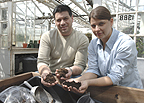May 09, 2007
Study suggests vermicompost aids broccoli growth

Caption follows story
CARBONDALE, Ill. — You won’t find worms and broccoli on a menu, but they make a good combination.
Southern Illinois University Carbondale senior April L. Vigardt, who grew up in Chicago, designed and conducted a 12-week experiment to find out if compost made by worms could replace peat moss in growing broccoli starts in the greenhouse and transplants out in the field. The short answer seems to be yes.
“My findings do seem to correlate with other research in the suitability of vermicompost as a greenhouse medium,” she stated in a report prepared for REACH, the University’s undergraduate research program, with faculty mentor Jorge D. Hernandez of the Department of Plant, Soil and Agricultural Systems.
“An increase in broccoli growth is usually seen with the addition of vermicompost, although all treatments high in vermicompost concentration did not show the best response.”
Why should we care whether broccoli grows in peat moss or vermicompost?
“A peat-based growing medium is a non-renewable resource harvested from peat bogs,” Vigardt said in an interview.
“When it’s gone, it’s gone.”
Worms also are easy and cheap to feed; they like food scraps, cattle manure and plant trimmings.
“These are things we have too much of and have problems getting rid of,” Vigardt said.
“When they go through the worms, they become a stable, peat-like substance, though more granular — like a rich, dark soil. It’s odorless, and the worms absorb only 5 percent of the nutrients; the rest pass through to become available to the plants.”
Vigardt grew starts in pots with no vermicompost, in pots containing only vermicompost and in pots of growing media mixed with 10 percent, 25 percent, 50 percent and 75 percent vermicompost. After three weeks, she took half the pots from each category and fertilized them, leaving the others alone. After six weeks, she transplanted the best of the starts from each group to a farm field in Anna. From the beginning, she took weekly measurements of stalk height, node height, node number and leaf number. After 12 weeks, she took plant tissue samples and analyzed them.
“Our research shows you can substitute up to 100 percent vermicompost (for peat) and it will not harm the growth,” Vigardt said.
“Broccoli grown in 75 percent to 100 percent vermicompost established better. We did see root development decline above 75 percent vermicompost, possibly due to initially high salt contents, but this did not affect their overall establishment in the field. We can’t say this will happen all the time because this was just one study.
“The height was the same for both the fertilized and non-fertilized treatments, while the number of leaves was higher for the fertilized treatment. At up to 75 percent vermicompost, the number of leaves in the unfertilized plants increased with the addition of vermicompost. Fertilized plants had the highest number of leaves with 25 percent vermicompost.”
Because the study was designed to run 12 weeks, Vigardt did not collect data on the flowerets, the part that people eat.
“But this is preliminary work — we wanted to see if it justified moving forward to a larger scale experiment,” Hernandez stressed.
“In the greenhouse, the growth was a little stunted and the stems curled a bit when you got over the 50 percent mark, but once it was in the field, it did fine.
“In some instances, the nutrients were higher than the plant needed, so this has to be managed carefully, but the broccoli did well and didn’t show any toxicity, even with high soluble salt content. Because the nutrients are in the root ball, they are available where the plants can use them. That means they’re also not in the field where they can run off.”
Vigardt, a 35-year-old non-traditional student, was torn between plant biology and plant and soil science when she started back to school. Some time spent in her “youth” on an organic farm prompted an interest in alternative crops, but she wasn’t sure the agriculture college was for her. She was interested in farming but thought she might want to do research instead.
Then, two years ago, she got a job managing Hernandez’ soil fertility lab. Shortly after, she applied for and won the REACH grant that funded this project.
“It was the best opportunity I’ve ever had,” Vigardt said.
“It gave me the opportunity to do my own research, to see what worked and what could go wrong, and to see how what I had learned fit into it. The classes became a lot more meaningful.”
(Editors, note: Vigardt is the daughter of Chicago residents Thomas A. Luzadder and Sandra L. Russell.)
Caption: Broccoli’s black gold — Jorge D. Hernandez, assistant professor of plant, soil and agricultural systems at Southern Illinois University Carbondale, and April L. Vigardt, a Chicago senior, hold handfuls of worm-made compost that Vigardt used in a research project on broccoli growth. She found it could replace peat moss in getting broccoli starts up and growing. Hernandez served as her mentor in the study, underwritten by REACH, the University’s program for undergraduate researchers.
